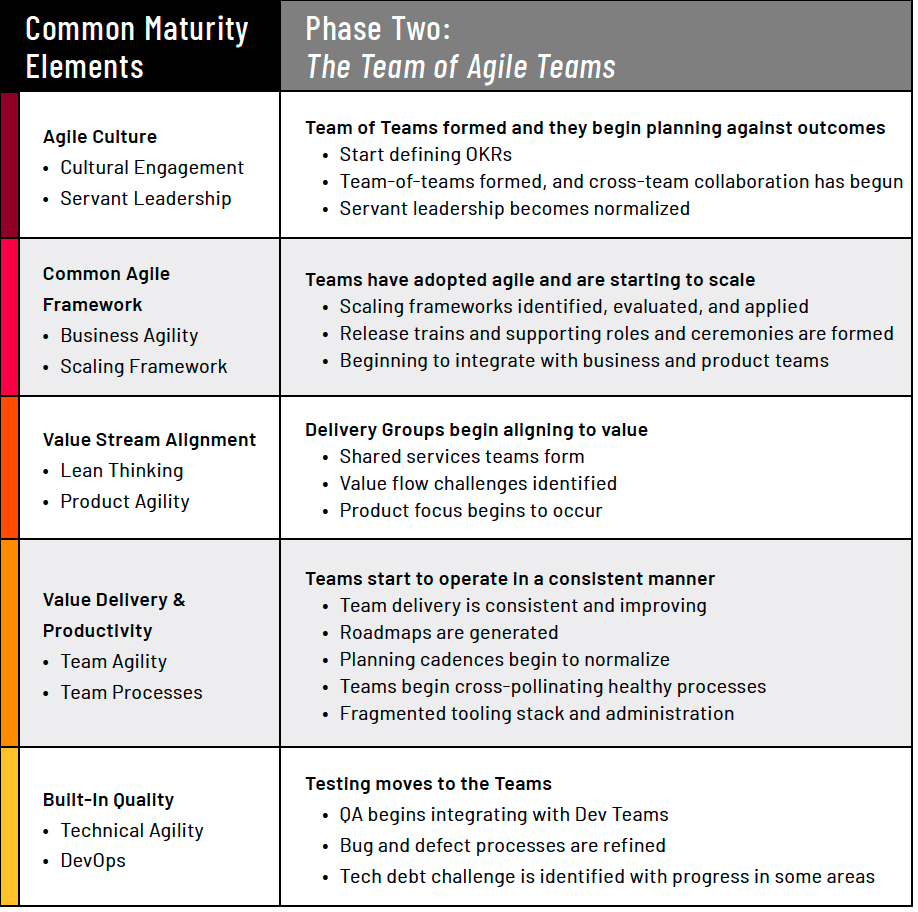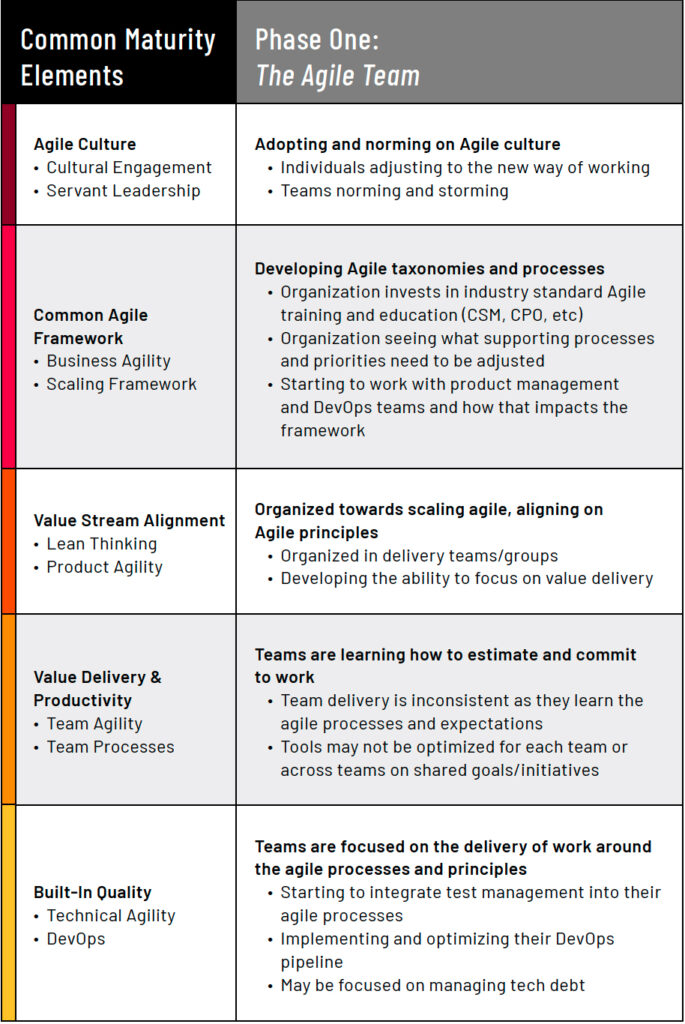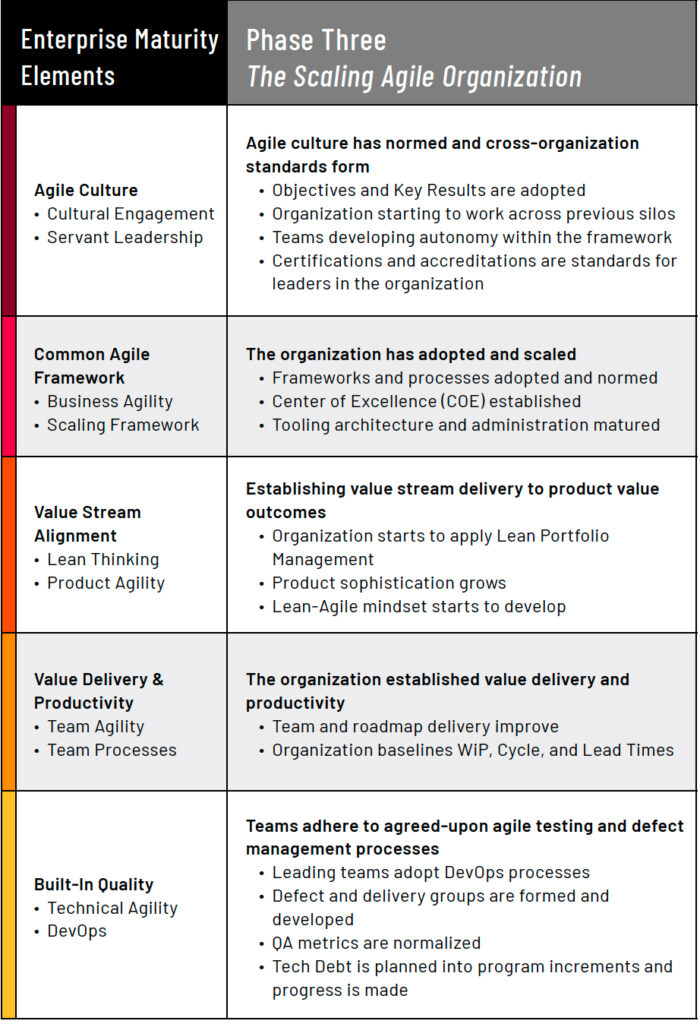Exploring the First Three Phases of Agile Maturity
Like a long and winding mountain road, the journey to agile maturity is neither fast nor straightforward. And if you try to take a shortcut, you’ll likely find yourself lost. On the other hand, you’re sure to reach your destination with a map in hand and a skilled navigator by your side.
In this series of articles, we want to share that map: a clear description of what you should expect to see across all five phases of Agile maturity. And, like trusted navigators, we share valuable advice about negotiating the turns, avoiding roadblocks, and enjoying the ride. Plus, we’ll talk about the optimal vehicle for each phase of your journey — enterprise product management software.
This article series includes excerpts from the free white paper, “The Five Phases of Enterprise Agility.” Download your free copy today.
Phase One – The Agile Team
This phase is usually the starting point for Agile in an organization. The team is focused on implementing and adopting Agile practices and methods, such as Scrum and Kanban, and designing cross-functional teams. This also involves making the teams stable and self-sufficient, implementing Agile tools, and co-locating workspaces if possible. These elements enable team-level agility that companies can build upon in future phases.
Software Features and Functionality
Teams at this phase are just starting to form and use Agile concepts for the first time. They need flexible, collaborative tools like Jira Software to help them move out of spreadsheets and manage Scrum and Kanban processes. As they progress toward Phase Two, Jira add-ons like Advanced Roadmaps, EazyBI, or Arsenale Dataplane will extend Jira’s functionality to support scaling. Confluence could also be used for team-level epic objectives, building business cases, roadmaps, sprint retrospectives, and demos.
Jira Align is optimally used by organizations with well-defined program-level teams, at least one team of teams, and some Portfolio level capabilities. As a result, Jira Align is not generally recommended for this phase since the organization is not yet structured around Agile roles or processes to best leverage Jira Align functionality.
Enabling Services
At this stage, help from knowledgeable and experienced Agile coaches and trainers can be invaluable. While they can help your teams build Agile technical skills and set up initial processes, they can also help guide the organization through the necessary transformation to move on to Phase Two.
If you’re in a Phase One organization, Cprime experts can meet you where you are to avoid common pitfalls, minimize risk during the transformation, and continue evolution and growth. Click to learn more about:
- Executive/Leadership Coaching
- Team Agile at Scale/Scrum/Kanban Coaching
- Jira Configuration and Optimization
- Agile Training
- Atlassian Quickstart Setup
- and more…
Phase Two – The Team of Agile Teams
This phase focuses on growing Scrum across multiple teams and forming a team of teams. With this level of maturity, the organization is expanding its ability to plan and deliver at the program level through forming a release train (and its core roles and responsibilities), facilitating Planning Increment (PI) Planning, and starting to align work to business value at the Portfolio level.
This is also the time to begin investing in Product Management and DevOps skills and tools to support and improve continuous delivery, but they are in the early stages of this phase. Additionally, there’s a focus on Agile leadership development to ensure guidance and support as the organization scales.

How Jira Align Supports The Team of Agile Teams
If you’re not familiar with Jira Align, read Introducing Jira Align — Agile Scaled for the Enterprise and explore the linked resources.
In Phase Two, organizations do well to seriously consider Jira Align. It offers incredible visibility through real-time and historical reporting and robust planning tools. As we move forward, we will approach the use of Jira Align in terms of the following levels that make up the Agile enterprise:
Strategic Level
Cross-enterprise, connecting strategy to execution; six-month to five-year planning horizon
Portfolio Level
Group of programs; three-month to 18-month planning horizon (usually in quarters)
Product Level
Product driven development, supports portfolio, program, and team levels
Program Level
Team of teams; planning horizon from now to 12 months, planned in PIs and sprints
Team Level
Agile team; planning horizon from now to six months, planned in PIs and sprints
Beginning in Phase Two, the focus is on coordinating between teams with an emphasis on value delivery by an Agile Release Train (ART). The primary focus in Jira Align at this phase is the program level.
Strategy Level
This is not the focus yet. It is more critical for Phase Two organizations to get teams working and planning together. Strategy documentation is often maintained in Confluence rather than Jira Align.
Portfolio Level
In Phase Two, the portfolio level is not yet a focus. For many organizations entering or transitioning through Phase Two, the main focus is modeling portfolio epics as a collection of features that deliver some system or capability.
Product Level
While most Phase Two organizations may not be product development-focused yet, those that are will find a friend in Jira Align. You can develop product road maps supported by journey maps, experience maps, personas, and even value-versus-effort points.
Program Level
The platform measures both output and business value delivered, unlike other platforms or tools that focus on output (stories completed, etc.) alone. In Phase Two, many organizations are still learning and are focused on output and delivering specific functionality within a PI.
Team Level
Phase Two organizations will find themselves leveraging the flexible functionality of Jira for much of the team activities, combined with the program level views in Jira Align to coordinate better across teams — conducting estimation poker, core sprints ceremonies, and some key analytics.
Enabling Services
At this stage, all the services recommended in Phase One still apply. Although they’re further along in the journey, adding new skills, ceremonies, and requirements means Agile training and coaching are still beneficial for teams and leaders alike. More advanced training and coaching may be called for, such as product dojos or training for in-house Agile coaches.
Jira Align is an incredibly powerful solution, but it’s easy for organizations to make the investment and then use a small percentage of the capabilities. Jira Align training and technical enablement will ensure the organization gets maximum return on investment. So, services specific to Jira Align will be invaluable if the organization decides to adopt the solution in preparation for Phase Three.
If you’re working in a Phase Two organization, let Cprime experts help maximize your growth and maturity:
- Jira Align Readiness Assessment and Implementation Services
- Value Stream Alignment
- Product Dojos
- Agile Coach Certification
- Training around Agile at Scale
- and more…
Phase Three – The Scaling Agile Organization
In this phase, the organization has adopted Agile at scale in one business group and is looking to expand it to other departments and supporting functions (like HR, Marketing, Finance, etc.) The Portfolio level has been developed and matures as they align on portfolio strategy, vision, and supporting roles. The organization is starting to see the value of Lean Portfolio Management (LPM) and OKRs, but they are aspirational as they focus on alignment to value streams and product delivery.
How Jira Align Supports The Scaling Agile Organization
The focus is on coordinating between trains and value delivery at a larger scale by several aligned ARTs. The primary focus in Jira Align at this phase is the portfolio level.
Jira Align’s “Why?” functionality is starting to allow team members to understand (in a concise view) how what they are building ties back to the bigger picture via portfolio epic purpose, feature, benefits, and even (potentially) themes. Combined with ongoing agile training and empowering teams, the organization is starting to align with what drives us as individuals.
Strategy Level
The organization is starting to model strategy in Jira Align as a multi-level goal structure over multiple time horizons via strategic snapshots. These are linked through strategic themes down to team execution of stories.
Portfolio Level
The organization is starting to implement Jira Align at the portfolio level with a focus on modeling the funding of groups of related portfolio epics and measuring value delivered through strategic themes modeled as Jira Align themes and portfolio objectives.
Product Level
At Phase Three, product becomes more prominent as an area of focus. Phase Three organizations may develop — and model in Jira Align — product visions as well as product roadmaps they want to see developed using personas and journey maps with a tie-back to value delivered by product and value stream.
Program Level
At Phase Three, the program level focus is shifting from predictable output to predictable delivered business value, as measured by program predictability and other business value-focused metrics.
Team Level
At Phase Three, the organization continues to improve team-level Agile practices using the combination of Jira and Jira Align. Teams will work in the platform (Jira Align) or tool (Jira) that best supports their personal choices and needs.
Enabling Services
Organizations at Phase Three have matured beyond needing some of the foundational services but may want to focus on broader and deeper services to continually develop agile maturity.
These include tool-specific training, intensive workshops or dojos to upskill team members, and coaching that focuses on optimization and scaling, governance, and quality.
If your organization is operating in Phase Three, contact Cprime to take advantage of these support services:
- Jira Training
- Jira Optimization
- Confluence Optimization
- Jira Align Optimization and Training
- Product Dojos
- Product Workshops
- DevOps Coaching, Training, and Tooling
- and more…
This article series includes excerpts from the free white paper, “The Five Phases of Enterprise Agility.” Download your free copy today.
In the next article in this series, we will explore the final phases of Enterprise Agility, The Agile Enterprise and The Scaling Agile Enterprise.





